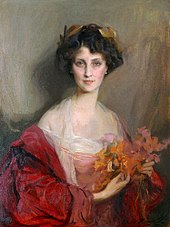Royal Society for the Protection of Birds
The Royal Society for the Protection of Birds (RSPB) is an organisation registered in Great Britain as a charity. It was founded as the Plumage League in 1889 by Emily Williamson.
| Company type | Conservation charity |
|---|---|
| Founded | 1889 - Fletcher Moss Botanical Garden, Manchester |
| Founder | Catherine Victoria Hall Eliza Phillips Margaretta Louisa Lemon |
| Headquarters | The Lodge, Sandy, Bedfordshire, England 2 Lochside View, Edinburgh, Scotland |
Area served | United Kingdom |
| Revenue | |
| 134,179,000 pound sterling (2017) | |
Number of employees |
|
| Website | www |

The RSPB works to promote conservation and protection of birds and the wider environment. It runs public awareness campaigns and petitions, and it operates nature reserves throughout the United Kingdom.[2]
The RSPB has 2,000 employees, 17,600 volunteers and more than a million members (including 150,000 youth members). It is the largest wildlife conservation charity in Europe.[3] The RSPB has many local groups and maintains 200 nature reserves.[4]
The group gained popularity and eventually amalgamated with the Fur and Feather League in Croydon to form the RSPB.[5]
The original members of the RSPB were all women. They campaigned against the fashion of wearing exotic feathers in hats. To this end the Society had two simple rules:[5]
- That Members shall discourage the wanton destruction of Birds, and interest themselves generally in their protection
- That Lady-Members shall refrain from wearing the feathers of any bird not killed for purposes of food, the ostrich only excepted.
— RSPB rules, 1899
At the time of founding, the trade in plumage for use in hats was very large: in the first quarter of 1884, almost 7,000 bird-of-paradise skins were being imported to Britain, along with 0.4 million birds from the West Indies and Brazil, and 0.36 million birds from British India.[6]
The Society attracted support from some women of high social standing who belonged to the social classes that popularised the wearing of feathered hats, including the Duchess of Portland (who became the Society's first President) and the Ranee of Sarawak. The organisation began to attract the support of many other influential figures, both male and female, such as the ornithologist Professor Alfred Newton. The society received a Royal Charter in 1904 from Edward VII. It petitioned Parliament to introduce laws banning the use of plumage in clothing.[7]
References
change- ↑ 1.0 1.1 1.2 RSPB Annual Report 2014
- ↑ "What does the RSPB do?". RSPB. Archived from the original on 2 January 2007. Retrieved 19 February 2007.
- ↑ "About the RSPB". RSPB. Archived from the original on 25 March 2012. Retrieved 19 February 2007.
- ↑ "Reserves". RSPB. Archived from the original on 21 September 2013. Retrieved 13 February 2010.
- ↑ 5.0 5.1 "History of the RSPB". RSPB. Archived from the original on 26 January 2007. Retrieved 19 February 2007.
- ↑ Adams, William Mark 2004. Against extinction: the story of conservation. Earthscan. ISBN 978-1-84407-055-8
- ↑ Milestones. RSPB